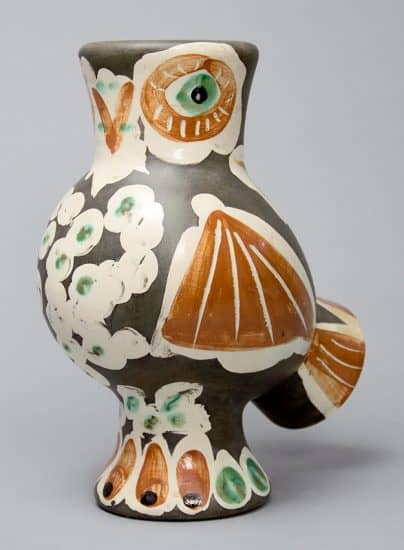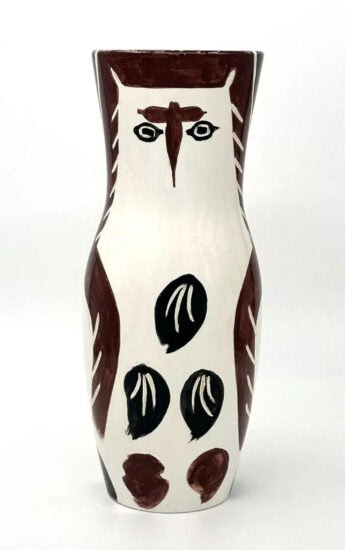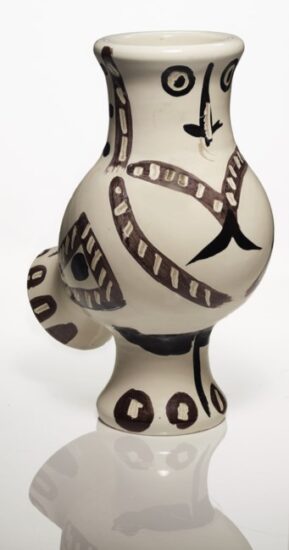Pablo Picasso Owls
In 1946, while living in the South of France, Picasso rescued an injured little owl in Antibes. He kept it as a pet in his studio for several years. Friends and visitors often recalled the bird’s piercing gaze and quirky personality, and Picasso developed a genuine affection for it. This direct, daily interaction made the owl a familiar and intimate subject for him. Picasso’s encounter with the little owl came during a transitional, almost tender chapter in his life, set against the warm light of the Côte d’Azur. He had recently ended his turbulent relationship with Dora Maar and was deeply involved with the young painter Françoise Gilot, whose presence brought a measure of stability and renewal after the stormy years of war and personal upheaval. The couple had moved into the Château Grimaldi in Antibes, where Picasso was working prolifically and experimenting with new mediums, including the ceramics that would soon dominate much of his creative output. When a small owl with an injured claw was found in the chateau’s rafters, Picasso took it in, nursing it back to health. The bird became both a studio companion and a quiet symbol of watchfulness, its round, unblinking eyes echoing the artist’s own acute powers of observation. The relationship between Picasso, Françoise, and the rescued owl unfolded in this moment of artistic fertility and emotional realignment — a rare period when Picasso’s domestic life, romantic life, and creative life were unusually harmonious, and when the owl’s image began to migrate into his drawings, paintings, and the playful, tactile surfaces of his ceramics. Here’s what Picasso’s muse Françoise Gilot—his companion during the time he befriended the owl—recounted in her memoir Life With Picasso, offering perhaps the only direct firsthand insight into that peculiar relationship: “We were very nice to him but he only glared at us... he remained stolidly silent or, at best, snorted.” Meanwhile, Picasso would tease the owl with playful insults like “Cochon, Merde,” trying to provoke a reaction. He even stuck his fingers through the cage bars until, bit by bit, the owl began to tolerate—and eventually perch upon—his finger. Throughout his long and prolific career, Pablo Picasso surrounded himself with animals both in life and in art, weaving them into the very fabric of his creative vision. From his earliest childhood in Málaga, where his father bred and painted doves, to the menagerie he kept as an adult, animals were constant companions and enduring symbols. The dove, which would later become an international emblem of peace through Picasso’s famous lithographs, carried for him a sense of grace and hope. The bull and the horse—drawn from the drama of the Spanish bullring—embodied raw power, courage, and the eternal struggle between life and death, recurring in masterpieces like Guernica. Dogs, cats, and goats appeared not merely as charming portraits of pets, but as spirited reflections of human temperament and instinct. This rescued owl, with its unblinking gaze, became a stand-in for wisdom and watchfulness, and often appeared in his ceramics and lithographs. The owl provided Picasso with a versatile, sculptural form that worked across mediums. In drawings and paintings, their rounded bodies, strong outlines, and expressive eyes translated well into simplified, Cubist-leaning forms. In ceramics, the owl’s bulbous shape could be naturally suggested by the vessel form, allowing Picasso to integrate painted details with the object’s 3D contours.
Buy Pablo Picasso Owls For Sale With Us
We guarantee the authenticity of the work. Your fine art purchase is always accompanied by our Certificate of Authenticity, historical documentation, and museum-archival framing. Read more


